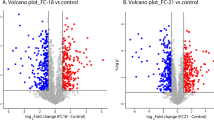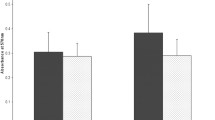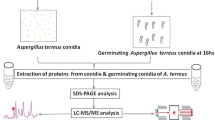Abstract
Metarhizium anisopliae is a naturally occurring cosmopolitan fungus infecting greyback canegrubs (Dermolepida albohirtum). The main molecular factors involved in the complex interactions occurring between the greyback canegrubs and M. anisopliae (FI-1045) were investigated by comparing the proteomes of healthy canegrubs, canegrubs infected with Metarhizium and fungus only. Differentially expressed proteins from the infected canegrubs were subjected to mass spectrometry to search for pathogenicity related proteins. Immune-related proteins of canegrubs identified in this study include cytoskeletal proteins (actin), cell communication proteins, proteases and peptidases. Fungal proteins identified include metalloproteins, acyl-CoA, cyclin proteins and chorismate mutase. Comparative proteome analysis provided a view into the cellular reactions triggered in the canegrub in response to the fungal infection at the onset of biological control.



Similar content being viewed by others
References
Andersen SO (1979) Biochemistry of the insect cuticle. Annu Rev Entomol 24:29–61
Andersen SO, Hojrup P, Roepstorff P (1995) Insect cuticular proteins. Insect Biochem Mol Biol 25:153–176
Bidochka MJ, St. Leger RJ, Roberts DW (1997) Induction of novel proteins in Manduca sexta and Blaberus giganteus as a response to fungal challenge. J Invertebr Pathol 70:184–189
Boucias DG, Hung SY, Mazet I, Azbell J (1994) Effect of the fungal pathogen, Beauveria bassiana, on the lysozyme activity in Spodoptera exigua larvae. J Insect Physiol 40:385–391
Chandler KJ, Erbacher JP (1997) Susceptibility of canegrubs to the insecticide chloropyrifos. Proc Soc Sugarcane Technol 19:118–126
Clarkson JM, Charnley AK (1996) New insights into the mechanisms of fungal pathogenesis in insects. Trends Microbiol 4:197–203
Engström Y, Loseva O, Theopold U (2004) Proteomics of the Drosophila immune response. Trends Biotechnol 22:600–605
Faria M, Wraight SP (2007) Mycoinsecticides and mycoacaricides: a comprehensive list with worldwide coverage and international classification of formulation types. Biocontrol 43:237–256
Ferron P (1978) Biological control of insect pests by entomogenous fungi. Annu Rev Entomol 23:409–442
Finnerty CM, Granados RR (1997) The plasma protein scolexin from Manduca sexta is induced by baculovirus infection and other immune challenges. Insect Biochem Mol Biol 27:1–7
Freimoser FM, Screen S, Bagga S, Hu G, St. Leger RJ (2003) Expressed sequence tag (EST) analysis of two subspecies of Metarhizium anisopliae reveals a plethora of secreted proteins with potential activity in insect hosts. Microbiology 149:239–247
Freimoser FM, Hu G, St. Leger RJ (2005) Variation in gene expression patterns as the insect pathogen Metarhizium anisopliae adapts to different host cuticles or nutrient deprivation in vitro. Microbiology 151:361–371
Frobius AC, Kanost MR, Gotz P, Vilcinskas A (2000) Isolation and characterization of novel serine protease inhibitors from larval hemolymph of greater wax moth Galleria mellonella. Eur J Biochem 267:2046–2053
Gillespie JP, Bateman R, Charnley AK (1998) The role for cuticle degrading proteases in the virulence of Metarhizium spp. for the desert locust, Schistocerca gregaria. J Invertebr Pathol 71:128–137
Grinyer J, McKay M, Nevalainen H, Herbert BR (2004) Fungal proteomics: initial mapping of biological control strain Trichoderma harzianum. Curr Genet 45:163–169
Guedes SDM, Vitorino R, Domingues R, Tomer K, Correia AJ, Amado F, Domingues P (2005) Proteomics of immune-challenged Drosophila melanogaster larvae hemolymph. Biochem Biophys Res Commun 328:106–115
Hajek AE, St. Leger RJ (1994) Interaction between fungal pathogens and insect hosts. Annu Rev Entomol 39:293–322
Jacklet JW (1997) Nitric oxide signaling in invertebrates. Invertbr Neurosci 3:1–14
Kanzok SM, Fechner A, Bauer H, Ulschmid JK, Müller H, Botella-Munoz J, Schneuwly S, Schirmer RH, Becker K (2001) Substitution of the thioredoxin system for glutathione reductase in Drosophila melanogaster. Science 291:643–646
Kershaw MJ, Moorhouse ER, Bateman RP, Reynolds SE, Charnley AK (1999) The role of destruxins in the pathogenicity of Metarhizium anisopliae for three species of insect. J Invertebr Pathol 74:213–223
Lee AY, Stewart JD, Clardy J, Ganem B (1995) New insight into the catalytic mechanism of chorismate mutases from structural studies. Chem Biol 2:195–203
Lengeler KB, Davidson RC, D’souza C, Harashima T, Shen W, Wang P, Pan X, Waugh M, Heitman J (2000) Signal transduction cascades regulating fungal development and virulence. Microbiol Mol Biol Rev 64:746–785
Levy F, Bulet P, Ehret-Sabatier L (2004) Proteomic analysis of the systemic immune response of Drosophila. Mol Cell Proteomics 3:156–166
Liu CM, Huang SS, Tzeng YM (2004) Analysis of destruxins produced from Metarhizium anisopliae by capillary electrophoresis. J Chromatogr Sci 42:140–145
Logan DP, Kettle CG (2002) Effect of food and larval density on survival and growth of early instar greyback canegrub, Dermolepida albohirtum (Waterhouse) (Coleoptera: Scarabaeidae). Aust J Entomol 41:253–261
Maeda H (1996) Role of metalloproteinases in pathogenesis. Microbiol Immunol 40:685–699
Merzendorfer H, Zimoch L (2003) Chitin metabolism in insects: structure, function and regulation of chitin synthases and chitinases. J Exp Biol 206:4393–4412
Milner RJ, Jenkins K (1996) Metarhizium: a versatile mycoinsecticide of the future. Prof Pest Manag 1:32–36
Milner RJ, Staples JA, Lutton GG (1998) The selection of isolates of the hyphomycete fungus, Metarhizium anisopliae for control of termites in Australia. Biol Control 11:240–247
Milner RJ, Samson P, Morton R (2003) Persistance of conidia of Metarhizium anisopliae in sugarcane fields: effect of isolate and formulation on persistence over 3.5 years. Biocontrol Sci Technol 13:507–516
Mounier N, Perriard JC, Gabbiani G, Chaponnier C (1997) Transfected muscle and non-muscle actins are differentially sorted by cultured smooth muscle and non-muscle cells. J Cell Sci 110:839–846
Murad AM, Laumann RA, Lima TA, Sarmento RB, Noronha EF, Rocha TL, Valadares-Inglis MC, Franco OL (2006) Screening of entomopathogenic Metarhizium anisopliae isolates and proteomic analysis of secretion synthesized in response to cowpea weevil (Callosobruchus maculatus) exoskeleton. Comp Biochem Physiol C Toxicol Pharmacol 142:365–370
Napolitano R, Juarez MP (1997) Entomopathogenous fungi degrade epiculticular hydrocarbons of T. infestans. Arch Biochem Biophys 344:208–214
Paterson IC, Charnley AK, Cooper RM, Clarkson JM (1994) Partial characterization of specific inducers of a cuticle-degrading protease of the insect pathogenic fungus, Metarhizium anisopliae. Microbiology 140:3153–3159
Powis G, Montfort WR (2001) Properties and biological activities of thioredoxins. Annu Rev Biophys Biomol Struct 30:421–455
Prior C, Carey M, Abraham YJ, Moore D, Bateman RP (1995) Development of a bioassay method for the selection of entomopathogenic fungi virulent to the desert locust Schistocerca gregaria (Forskal). J Appl Entomol 119:567–572
Rivero A (2006) Nitric oxide: an antiparasitic molecule of invertebrates. Trends Parasitol 22:219–225
Rosengren AT, Salmi JM, Aittokallio T, Westerholm J, Lahesmaa R, Nyman TA, Nevalainen OS (2003) Comparison of PDQuest and Progenesis software packages in the analysis of two-dimensional electrophoresis gels. Proteomics 3:1936–1946
Samson PR, Milner RJ, Sander ED, Bullard GK (2005) Effect of fungicides and insecticides applied during planting of sugarcane on viability of Metarhizium anisopliae and its efficacy against white grubs. Biocontrol 50:151–163
Samuels RI, Paterson IC (1995) Cuticle-degrading proteases from insect moulting fluid and culture filtrates of entomopathogenic fungi. Comp Biochem Physiol 110:661–669
Shen Z, Edwards MJ, Jacobs-Lorena M (2000) A gut-specific serine protease from the malaria vector Anopheles gambiae is down-regulated after blood ingestion. Insect Mol Biol 9:223–229
St. Leger RJ, Charnley AK, Cooper RM (1987) Production of cuticle-degrading enzymes by the entomopathogen, Metarhizium anisopliae during infection of cuticles from Calliphora vomitoria and Manduca sexta. J Gen Microbiol 133:1371–1382
St. Leger RJ, Durrands PK, Charnley AK, Cooper RM (1988) Regulation of production of proteolytic enzymes by the entomopathogenic fungus Metarhizium anisopliae. Arch Microbiol 150:413–416
St. Leger RJ, Butt TM, Staples RC, Roberts DW (1989) Production in vitro of appressoria by the entomopathogenic fungus Metarhizium anisopliae. Exp Mycol 13:274–288
St. Leger RJ, Bodichka MJ, Roberts DW (1994) Isoforms of the cuticle-degrading Pr 1 proteinase and production of a metalloproteinase by Metarhizium anisopliae. Arch Biochem Biophys 313:1–7
St. Leger RJ, Joshi L, Roberts D (1997) Ambient pH is a major determinant in the expression of cuticle-degrading enzymes and hydrophobin by Metarhizium anisopliae. Appl Environ Microbiol 64:709–713
Strater N, Schnappauf G, Braus G, Lipscomb WN (1997) Mechanisms of catalysis and allosteric regulation of yeast chorismate mutase from crystal structures. Structure 5:1437–1452
Vierstraete E, Verleyen P, Baggerman G, D’Hertog W, Van den Bergh G, Arckens L, De Loof A, Schoofs L (2003) A proteomic approach for the analysis of instantly released wound and immune proteins in Drosophila melanogaster hemolymph. Proc Natl Acad Sci USA 101:470–475
Wahlman M, Davidson BS (1993) New destruxins from the entomopathogenic fungus Metarhizium anisopliae. J Nat Prod 56:643–647
Wang C, St. Leger RJ (2006) A collagenous protective coat enables Metarhizium anisopliae to evade insect immune responses. Proc Natl Acad Sci USA 103:6647–6652
Wang C, St. Leger RJ (2007) A scorpion neurotoxin increases the potency of a fungal insecticide. Nat Biotechnol 25:1455–1456
Weiske LJ, Weisner A (1999) Stimulation of NO synthase activity in the immune-competent lepidopteran Estigmene acraea haemocyte line. Nitric Oxide 3:1
Yu AY, Houry WA (2007) ClpP: a distinctive family of cylindrical energy-dependent serine proteases. FEBS Lett 581:3749–3757
Author information
Authors and Affiliations
Corresponding author
Additional information
Communicated by J. Heitman.
Rights and permissions
About this article
Cite this article
Manalil, N.S., Junior Te’o, V.S., Braithwaite, K. et al. A proteomic view into infection of greyback canegrubs (Dermolepida albohirtum) by Metarhizium anisopliae . Curr Genet 55, 571–581 (2009). https://doi.org/10.1007/s00294-009-0270-x
Received:
Revised:
Accepted:
Published:
Issue Date:
DOI: https://doi.org/10.1007/s00294-009-0270-x




